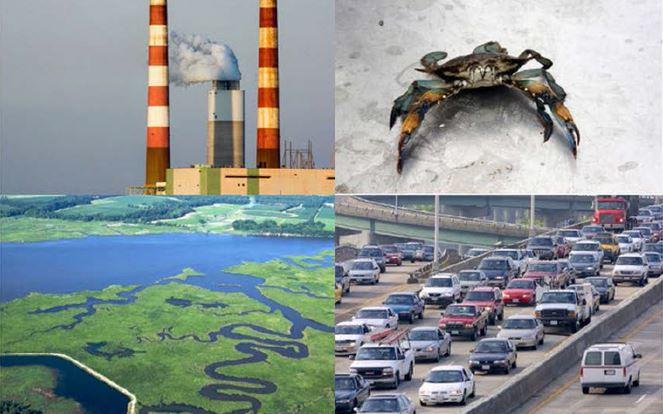Chesapeake Bay - CMAQ

The Chesapeake Bay watershed spans more than 64,000 square miles and is home to nearly 18 million people. Despite decades of restoration efforts, a total maximum daily load![]() total maximum daily loadA regulatory term in the U.S. Clean Water Act, describing a value of the maximum amount of a pollutant that a body of water can receive while still meeting water quality standards. Alternatively, TMDL is an allocation of that water pollutant deemed acceptable to the subject receiving waters. TMDLs have been used extensively by the EPA and state environmental agencies in implementing the Clean Water Act by establishing maximum pollution limits for industrial wastewater dischargers. (TMDL) was established for the Chesapeake Bay watershed in 2010 due to poor water quality. Atmospheric deposition is the second largest source of nitrogen to the Chesapeake Bay watershed and represents an important source of N loading. CMAQ modeled N deposition is used by Chesapeake Bay Program (CBP) as a nitrogen input to characterize the reduction of atmospheric N loading over the past few decades.
total maximum daily loadA regulatory term in the U.S. Clean Water Act, describing a value of the maximum amount of a pollutant that a body of water can receive while still meeting water quality standards. Alternatively, TMDL is an allocation of that water pollutant deemed acceptable to the subject receiving waters. TMDLs have been used extensively by the EPA and state environmental agencies in implementing the Clean Water Act by establishing maximum pollution limits for industrial wastewater dischargers. (TMDL) was established for the Chesapeake Bay watershed in 2010 due to poor water quality. Atmospheric deposition is the second largest source of nitrogen to the Chesapeake Bay watershed and represents an important source of N loading. CMAQ modeled N deposition is used by Chesapeake Bay Program (CBP) as a nitrogen input to characterize the reduction of atmospheric N loading over the past few decades.
CBP also provides estimates of future deposition scenarios that include reductions to NOx![]() NOxGases consisting of one molecule of nitrogen and varying numbers of oxygen molecules. Nitrogen oxides are produced in the emissions of vehicle exhausts and from power stations. In the atmosphere, nitrogen oxides can contribute to formation of photochemical ozone (smog), can impair visibility, and have health consequences; they are thus considered pollutants. emissions. The CBP uses linked state-of-the-science modeling tools which includes CMAQ to estimate the N loading to the watershed, transport and transformation to the estuaries and to assess the impact of existing and future regulations on water quality in the Chesapeake Bay.
NOxGases consisting of one molecule of nitrogen and varying numbers of oxygen molecules. Nitrogen oxides are produced in the emissions of vehicle exhausts and from power stations. In the atmosphere, nitrogen oxides can contribute to formation of photochemical ozone (smog), can impair visibility, and have health consequences; they are thus considered pollutants. emissions. The CBP uses linked state-of-the-science modeling tools which includes CMAQ to estimate the N loading to the watershed, transport and transformation to the estuaries and to assess the impact of existing and future regulations on water quality in the Chesapeake Bay.
